Prince Bernhard of Lippe-Biesterfeld
| Bernhard of Lippe-Biesterfeld | |||||
|---|---|---|---|---|---|
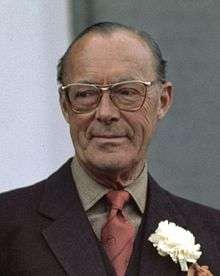 Prince Bernhard in 1976 wearing his trademark carnation | |||||
| Prince consort of the Netherlands | |||||
| Tenure | 6 September 1948 – 30 April 1980 | ||||
| Born |
29 June 1911 Jena, Saxe-Weimar-Eisenach, German Empire | ||||
| Died |
1 December 2004 (aged 93) University Medical Center Utrecht, Utrecht, Netherlands | ||||
| Burial |
11 December 2004 Nieuwe Kerk, Delft, Netherlands | ||||
| Spouse | Juliana of the Netherlands (m. 1937; d. 2004) | ||||
| Issue |
Beatrix of the Netherlands Princess Irene of the Netherlands Princess Margriet of the Netherlands Princess Christina of the Netherlands Alicia von Bielefeld Alexia Grinda | ||||
| |||||
| House | Lippe | ||||
| Father | Prince Bernhard of Lippe | ||||
| Mother | Armgard von Cramm | ||||
| Religion |
Church of Lippe (until 1937) Dutch Reformed Church (1937–2004) Protestant Church in the Netherlands (2004) | ||||
| Occupation |
Military officer Aviator Conservationist Nonprofit director | ||||
| Signature |
 | ||||
Prince Bernhard of Lippe-Biesterfeld (Prince Bernhard Leopold Frederik Everhard Julius Coert Karel Godfried Pieter of Lippe-Biesterfeld) (Born as: Bernhard Friedrich Eberhard Leopold Julius Kurt Carl Gottfried Peter Graf von Biesterfeld; 29 June 1911 – 1 December 2004), later Prince Bernhard of the Netherlands, was the husband of Queen Juliana of the Netherlands and father of her four children, including the former Queen of the Netherlands, Princess Beatrix.
Although his private life was rather controversial, he was still generally regarded as a charming and popular figure by the majority of the Dutch for his performance as a combat pilot and his activities as a liaison officer and personal aide to the Queen during World War II and for his work during post-war reconstruction.
During World War II the German-born prince was part of the London-based Allied war planning councils and saw active service as a Wing Commander (RAF) flying both fighter and bomber planes into combat. He was a Dutch General and Supreme Commander of the Dutch Armed forces, involved in negotiating the terms of surrender of the German Army in the Netherlands.
For proven bravery, leadership and loyalty during his wartime efforts he was appointed a Commander of the Military William Order, the Netherlands' oldest and highest honour. After the War he was also made Honorary Air Marshal of the RAF by Queen Elizabeth II. In 1969, Bernhard was awarded the Grand Cross (Special Class) of the Order of Merit of the Federal Republic of Germany.
Bernhard helped found the World Wildlife Fund (later renamed World Wide Fund for Nature), becoming its first President in 1961, and in 1970 establishing the WWF's financial endowment "The 1001: A Nature Trust". In 1954, he was a co-founder of the international Bilderberg Group, which has met annually since then to discuss corporate globalization and other issues concerning Europe and North America. He was forced to step down from both groups after being involved in the Lockheed Bribery Scandal.
Early life
Bernhard was born Bernhard Leopold Friedrich Eberhard Julius Kurt Karl Gottfried Peter Graf von Biesterfeld in Jena, Saxe-Weimar-Eisenach, German Empire on 29 June 1911, the elder son of Prince Bernhard of Lippe (younger brother of Leopold IV, Prince of Lippe, the reigning Prince of Lippe) and his wife, Armgard von Cramm. Because his parents marriage did not properly conform with the marriage laws of the House of Lippe, it was deemed morganatic, so Bernhard was only granted the title of "Count of Biesterfeld" at birth. He and his brother could only succeed to the Lippian throne if the entire reigning House became extinct. In 1916, the Reigning Prince of Lippe, Leopold IV, raised Bernhard and his mother to "Prince / Princess of Lippe-Biesterfeld" thereby retroactively according his parents' marriage regal status. The suffix Biesterfeld was revived to mark the beginning of a new cadet line of the House of Lippe.[1][2][3]
After World War I, Bernhard's family lost their German Principality and the revenue that had accompanied it. But the family was still wealthy and Bernhard spent his early years at Castle Reckenwalde, the family's new estate in East Brandenburg thirty kilometers east of the River Oder, (now the village of Wojnowo, Lubusz Voivodeship in Poland), near the city of Züllichau (Sulechów). He received his early education at home. When he was twelve, he was sent to board at the Gymnasium in Züllichau and several years later to board at a Gymnasium in Berlin, from which he graduated in 1929.
Bernhard suffered from poor health as a boy. Doctors predicted that he would not live very long. This prediction might have been the key to Bernhard's reckless driving and the risks that he took in the Second World War and thereafter. The prince wrecked several cars and planes in his lifetime.
Bernhard studied Law at the University of Lausanne, Switzerland and in Berlin, where he acquired a taste for fast cars, horse riding, and big-game hunting safaris. He was nearly killed in a boating accident and an airplane crash, and he suffered a broken neck and crushed ribs in a 160 km/h (100 mph) car crash in 1938.
While at university, Bernhard joined the Nazi Party. He also enrolled in the Sturmabteilung (SA), which he left in 1934 when he graduated.[4] The Prince later denied that he had belonged to SA, to the Reiter-SS (SS Cavalry Corps), and to the NSKK, but these are well-documented memberships. Nevertheless, while he was not a fierce champion of democracy, the Prince was never known to hold any radical political views or express any racist sentiments.
The Prince eventually went to work for the German chemical giant IG Farben, then the world's fourth-largest company (which survives today as BASF, AGFA, and Bayer). He lodged with the exiled Russian nobleman Count Pavel Kotzbue and his wife the American-born Allene Tew. After training, Bernhard became secretary to the board of directors at the Paris office in 1935.
Marriage and children
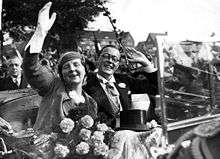
Bernhard met then-Princess Juliana at the 1936 Winter Olympics at Garmisch-Partenkirchen. Juliana's mother, Queen Wilhelmina, had spent most of the 1930s looking for a suitable husband for Juliana. As a Protestant of royal rank (the Lippe-Biesterfelds were a sovereign house in the German Empire), Bernhard was acceptable for the devoutly religious Wilhelmina. Wilhelmina left nothing to chance, and had her lawyers draft a very detailed prenuptial agreement that specified exactly what Bernhard could and could not do. The couple's engagement was announced in 1936, and they were married at The Hague on 7 January 1937. Earlier, Bernhard had been granted Dutch citizenship, and changed the spelling of his names from German to Dutch. Previously styled as Serene Highness, he became a Royal Highness by Dutch Law. His appropriateness as consort of the future Queen would later become a matter of some public debate.
Prince Bernhard was father of six children, four of them with Queen Juliana. The eldest daughter is Princess Beatrix, former Queen of the Netherlands, (1938). His other daughters with Juliana are Irene (1939), Margriet (1943) and Christina (1947).


He had two illegitimate daughters. The first is Alicia von Bielefeld (born 21 June 1952), whose mother has not been identified. She is a landscape architect and lives in the United States. Prince Bernhard's sixth daughter, Alexia Grinda (a.k.a. Alexia Lejeune or Alexia Grinda-Lejeune, born in Paris on 10 July 1967), is his child by the French socialite and fashion model Hélène Grinda.[5] Although rumours about these two children had already spread, it was made official after his death. In December 2008, Dutch historian Cees Fasseur claimed that former British Conservative Cabinet Minister Jonathan Aitken was the result of a wartime affair between Prince Bernhard and Aitken's mother, previously Penelope Maffey.[6]
Attitudes to Nazi Germany
Prince Bernhard was a member of the "Reiter-SS", a mounted unit of the SS and joined the Nazi party.[7] He later also joined the National Socialist Motor Corps.
Various members of his family and friends were aligned with the Nazis prior to the Second World War, a number of whom attended the royal wedding. Protocol demanded that the prospective Prince-Consort be invited to an audience with his head of state, who at the time was Adolf Hitler. Hitler himself gives an account of the conversation he had with Bernhard in his Tischgespräche (Table Conversations). Table Conversations was a collection of monologues, remarks, and speeches Hitler gave during lunch or dinner to those invited to the table by him. Bernhard himself called Hitler a tyrant in a public speech on the BBC on 25 June 1940 after France fell to Germany.
The Prince's brother, Prince Aschwin of Lippe-Biesterfeld, was an officer in the German Army. Although the secret services on both sides were interested in this peculiar pair of brothers, no improper contacts or leaks of information were ever discovered. The Prince proved himself to be a loyal Dutch citizen and officer. He cut off relations with those members of his family who were enthusiastic Nazis. As a sign of his "Dutchness" he spoke only Dutch when negotiating the surrender of German forces in the Netherlands. The Prince was known to be very fond of smart uniforms and medals. He made a point of wearing his medals in the English court style, even though members of the Dutch armed forces wear their medals in the Prussian style.
The Prince's mother was no admirer of the Nazis and got into trouble for refusing to hoist the swastika flag on her country seat at Reckenwalde.
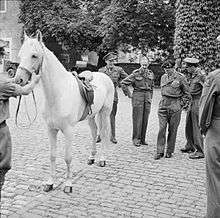
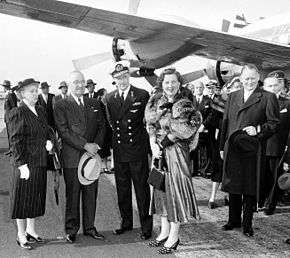
Second World War
Prince Bernhard began to make himself popular in the eyes of the Dutch people at the outset of the Second World War. During the German invasion of the Netherlands, the Prince, carrying a machine gun, organised the palace guards into a combat group and shot at German warplanes. The Royal family fled the Netherlands and took refuge in England. In disagreement with Queen Wilhelmina's decision to leave the Kingdom, the young Prince Consort, aged 28, is said at first to have refused to go and to have wanted to oppose the Nazi occupation from within the country. However, in the end he agreed to join his wife and become head of the Royal Military Mission based in London. Once safely there, his wife Princess Juliana and their children went on to Canada, where they remained until the end of the war.
In England, Prince Bernhard asked to work in British Intelligence but the War Admiralty, and later General Eisenhower's Allied Command offices, did not trust him sufficiently to allow him access to sensitive intelligence information. However, on the recommendation of Bernhard's friend and admirer King George VI, who was also of German aristocratic descent through his mother Mary of Teck and his great-grandfather Prince Albert, and after being personally screened by intelligence officer Ian Fleming at the behest of Churchill, he was later given work to do in the Allied War Planning Councils.
"For Bernhard, the Prince of the Netherlands, the war was a frustrating business. Born a German, he had married Queen Wilhelmina's only child, Princess Juliana, and in due time made a conscious and meaningful transition of loyalties to his new homeland. Because of this, and in view of the doubts his background initially evoked among some Britons, he longed more than anyone for a chance to get at Holland's aggressors." Erik Hazelhoff Roelfzema aka Soldier of Orange, decorated war hero.[8]
On 25 June 1940, three days after France fell to the German war machine, Bernhard spoke on the Overseas Service of the BBC, calling Hitler a German tyrant and expressing his confidence that Great Britain would defeat the Third Reich.
In 1940, Flight Lieutenant Murray Payne gave the Prince instruction in flying a Spitfire. The Prince made 1,000 flight-hours in a Spitfire with the RAF's No. 322 (Dutch) Squadron RAF, wrecking two planes during landings. He remained an active pilot throughout his life and flew his last airplane 53 years later, with his grandson and heir to the throne, who inherited his passion for flying.
In 1941, Prince Bernhard was given the honorary rank of wing commander in the Royal Air Force. As "Wing Commander Gibbs (RAF)", Prince Bernhard flew over occupied Europe, attacking V-1 launch pads in a B-24 Liberator, bombing Pisa and engaging submarines over the Atlantic in a B-25 Mitchell and conducting reconnaissance over enemy-held territory in an L-5 Grasshopper. Prince Bernhard was awarded the Dutch Airman's Cross for his "ability and perseverance" (Dutch: "bekwaamheid en volharding").[9] In 1941 he also received a promotion to Honorary Air Commodore.[10]
He also helped organised the Dutch resistance movement and acted as personal secretary for Queen Wilhelmina.
Queen Wilhelmina erased the style "honorary" (the exact words were "à la suite") in the decree promoting Bernhard to General. In this unconstitutional manner, she gave this Royal Prince a status that was never intended by either Parliament or her Ministers. The Minister of Defence did not choose to correct the Monarch and the Prince took an active and important role in the Dutch Armed forces.
By 1944, Prince Bernhard became Commander of the Dutch Armed Forces. After the liberation of the Netherlands, he returned with his family and became active in the negotiations for the German surrender. He was present during the Armistice negotiations and German surrender at Hotel de Wereld ("The World Hotel"), Wageningen in The Netherlands on 5 May 1945, where he avoided speaking German.[11][12] The Prince was a genuine war hero in the eyes of most of the Dutch and even kept cordial relations with the Communists who fought against the Nazis. In the post-war years he earned respect for his work in helping to reinvigorate the economy of the Netherlands.
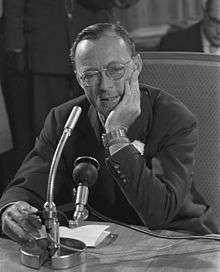
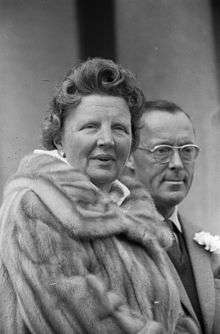



.jpg)
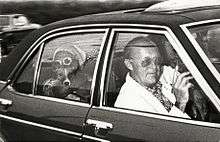
Postwar roles
After the War, the position of Inspector General was created for the Prince.
He was made a member of the boards of supervisors of Fokker Aircraft and KLM Royal Dutch Airlines, and within a few years he had been invited to serve as an adviser or non-executive director of numerous corporations and institutions. There have been claims about KLM helping Nazis to leave Germany for Argentina on KLM flights while Bernhard was on its board.[13] After a 1952 trip with Queen Juliana to the United States, Prince Bernhard was heralded by the media as a business ambassador extraordinaire for the Netherlands.[14]
With his global contacts, Bernhard in May 1954, was a key figure in organising a meeting at the Bilderberg Hotel in the Netherlands for the business elite and intellectuals of the Western World to discuss the economic problems in the face of what they characterized as the growing threat from Communism. This first meeting was successful, and it became an annual gathering known as the Bilderberg Group. The idea for the European Union, first proposed by Robert Schuman on 9 May 1950, was encouraged at Bilderberg.
Prince Bernhard was a very outspoken person who often flouted protocol by remarking upon subjects about which he felt deeply. Almost until his last day he called for more recognition for the Polish veterans of the Second World War who had figured greatly in the liberation of the Netherlands, but only after his death did the Dutch Government decide to publicly recognize the important role of the Polish Army in the liberation: on 31 May 2006, at the Binnenhof in The Hague, Queen Beatrix conferred the Military William Order, the highest Dutch military decoration, on the Polish 1st Independent Parachute Brigade.
Friendships and International connections
Prince Bernhard was seen as a jet-setting and charismatic ambassador for the Dutch during post-war reconstruction.[15][16] Because of his connections Prince Bernhard reportedly maintained friendships with several high-profiled international figures, some of this verified friendships included: Nelson Mandela,[17][18][19][20] David Rockefeller,[21][22][23] Mohammad Reza Pahlavi,[24][25] Ian Fleming.[26][27][28]
Scandals and insinuations
The Hofmans Affair
In the middle of the 1950s, Prince Bernhard was involved in what some considered a personal vendetta against Greet Hofmans, a faith healer and layer-on of hands. For nine years she was a friend and adviser of Queen Juliana, often residing at Palace Soestdijk. Originally, Hofmans was introduced to Queen Juliana on the initiative of Prince Bernhard in 1948 to treat the eye sickness of Princess Marijke Christina. This illness arose because Juliana was infected with rubella during pregnancy. Hofmans developed a great influence on the Queen, encouraging pacifist ideas. In the period of the Cold War this caused a crisis in the Royal Household. Reputedly it reached the point where it threatened the marriage of Juliana and Bernhard.
Outside the Netherlands, a great deal was written about the Hofmans affair. On 13 June 1956, an article appeared in the German magazine Der Spiegel with the title "Zwischen Königin und Rasputin" – "between the Queen and her Rasputin", which painted a less-than-flattering picture of Hofmans. Later, Bernhard admitted that he personally provided the information for the article. It is thought that by doing this he hoped to have Hofmans removed from the court. The Prime Minister, Willem Drees, had to act and appointed a committee of "three wise men" (elder statesmen) to advise the royal couple. The Prince got what he wanted; Hofmans was banished, and various friends and supporters of the Queen in the Royal Household had to give up their office.
In 2008 the report of the "three wise men" has been made public and forms part of the book Juliana & Bernhard by historian Fasseur, who was also granted access to the private royal archive by the Queen. Bernhard was reprimanded for leaking confidential information to the international press, but although both Juliana and Princess Wilhelmina (the former Queen) mention their fear of a "German putsch" (i.e. Juliana's abdication followed by Bernhard's rule on behalf of their adolescent oldest daughter and successor to the throne) Juliana was forced to break all relations with Hofmans.
The book attempts to rehabilitate Bernhard, describing how the Prince only resorted to bringing in the international press after repeated, desperate and often dramatic pleading with his wife to distance herself from the Hofmans clan. Fasseur said: "Bernard was obviously a free spirited chap, who independently went about his business. But he was still very much a family man. I got the feeling he was the only one that was seeing things were getting completely out of hand and tried to salvage the situation as much as he could."[29]
The royal family did not edit the book, nor did they have a preview before its printing. But after reading it they endorsed its accounts of the developments that led to Hofmans's dismissal.
The Lockheed scandal
Scandal rocked the Royal Family in 1976 when it was revealed that Prince Bernhard had accepted a US$1.1 million bribe from U.S. aircraft manufacturer Lockheed Corporation to influence the Dutch Government's purchase of fighter aircraft. At the time he had served on more than 300 corporate boards and committees worldwide and had been praised in the Netherlands for his efforts to promote the economic well-being of the country. Prime Minister of the Netherlands Joop den Uyl ordered an inquiry into the Lockheed affair, while Prince Bernhard refused to answer reporters' questions, stating: "I am above such things".[30]
The Dutch and international press headlined the stories for months, providing records of Prince Bernhard's Reiter SS membership and details of his numerous extramarital affairs, including the purchase of a luxurious Paris apartment for his mistress Hélène Grinda, with whom he had an illegitimate daughter, Alexia. (Bernhard also had a second illegitimate daughter, Alicia, in the USA.)
On 26 August 1976, a toned-down, but nonetheless devastating, report on Prince Bernhard's activities was released to a shocked Dutch public. The Prince's own letter of 1974, to Lockheed Corporation, demanding "commissions" be paid to him on Dutch Government aircraft purchases was very damaging evidence of improper conduct by the Inspector-General of the Dutch Armed Forces. Criminal charges were not pressed by the Government out of respect for Queen Juliana, whose later abdication was tacitly understood to be directly related to her husband's conduct.
Prince Bernhard resigned as Inspector-General of the Dutch Armed Forces. This meant that he was no longer officially allowed to wear a uniform in public, but it did not stop him from attending the 1979 funeral of Lord Mountbatten in London in full military dress.
Prime Minister Joop den Uyl made a statement in Parliament and told the delegates that the Prince would also resign from his various high-profile positions in businesses, charities, and other institutions. The Dutch States-General voted against criminal prosecution. Prince Bernhard turned over the Presidency of the international World Wildlife Fund to Prince Philip, Duke of Edinburgh. The Dutch Royal Family worked hard to rehabilitate the Prince's name, though other scandals were to be revealed in later years.
Project Lock

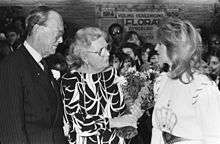
In 1988, Prince Bernhard and Princess Juliana sold two paintings from their personal collection to raise money for the World Wildlife Fund. The paintings sold for GBP700,000, which was deposited in a Swiss WWF bank account. In 1989, however, Charles de Haes, Director-General of the WWF, transferred GBP500,000 back to Bernhard, for what De Haes called a private project. In 1991, newspapers reported what this private project was: Prince Bernhard had hired KAS International, owned by Special Air Service founder Sir David Stirling, to use mercenaries – mostly British – to fight poachers in nature reserves.[31] The paramilitary group infiltrated organisations profiting from illegal trade in ivory in order to arrest them.
This Project Lock seemed to have backfired enormously, however. Bernhard's private army had not only infiltrated in the illegal trade, they were also participating in it. To make things worse, Irish reporter Kevin Dowling discovered that the South African Army was also involved in the trade, hinting at connections between the Bernhard's troops and the WWF and the struggle for maintaining Apartheid. Moreover, he claimed members of the South African-run counterinsurgency unit Koevoet (Afrikaans and Dutch for "crowbar") had been trained under Project Lock.
In 1995, Nelson Mandela called upon the Kumleben Commission to investigate, among other things, the role of the WWF in apartheid-South Africa. In the report that followed, it was suggested that mercenaries from Project Lock had planned assassinations of ANC members and that mercenaries had been running training camps in the wildlife reserves, training fighters from the anti-communist groups UNITA and Renamo. Although Prince Bernhard was never accused of any crime in this context, the Project Lock scandal dealt another damaging blow to the Prince's reputation.
Other controversies
Yet more controversy came on 30 October 2002, when he paid the fines of two Albert Heijn supermarket staff members, who were convicted of assaulting a shoplifter after they detained him.
In an interview published after his death, on 14 December 2004, Prince Bernhard admitted that he had accepted more than one million dollars (US) in bribes from Lockheed. He acknowledged it was a mistake and claimed that all of the money went to the WWF. He said: "I have accepted that the word Lockheed will be carved on my tombstone."[32] He also admitted to having fathered two illegitimate daughters in the years following his marriage.[33]
In February 2008, Joop den Uyl's biography claimed that the official report investigating the Lockheed bribe scandal also presented proof that the Prince had accepted money from yet another aerospace firm: Northrop. The former Prime Minister claimed he had not made the information public to protect the Dutch monarchy.[34]
The 2009 publication HRH: High Stakes at the Court of His Royal Highness by historian Harry Veenendaal and journalist Jort Kelder alleges that the Prince in 1950 attempted to oust the young government of the newly founded Republic of Indonesia and place himself to lead the Islands as Viceroy similar to Lord Mountbatten's role in British India. This was particularly contentious as in 1949 the Netherlands had already officially recognised its former colony as an independent nation.[35]
Death
In 1994 the Prince had a colon tumor removed and suffered severe complications due to respiratory distress. In December, his daughter Queen Beatrix rushed to the hospital straight after landing from a trip to Africa. By Christmas the prospect of death had faded and spring the next year he recovered enough to go home. His health problems continued in 1998 when he had a prostate swelling and in 1999 when he suffered difficulties breathing and talking. He did, however, attend the wedding of his grandson, straight after having prostate surgery. In 2000, his life was endangered again when he suffered neurological complications and continued breathing problems. Two days after intensive medical (and media) attention the Royal Press Office issued a statement the Prince was reading newspapers again.




Over the following years Bernhard continued to shine at the military parades on the national liberation day celebrating the defeat of Nazi Germany. Only when his wife Juliana died in March 2004 did the deeply upset Prince become exceedingly fragile. Up to the last moment it remained uncertain if he could attend the Royal funeral, which he eventually managed to attend. He said his final farewells to his war comrades on Liberation Day in May and in November that same year he was diagnosed with untreatable cancer.[36]
Prince Bernhard died of cancer at the age of 93 in a Utrecht hospital (the Universitair Medisch Centrum Utrecht – University of Utrecht Medical Centre) on 1 December 2004; until his death he suffered from malignant lung and intestinal tumors. On 11 December 2004, he was interred with a lavish state funeral at the Nieuwe Kerk, Delft. Bernhard's funeral was different from those of Prince Claus and Queen Juliana in that Bernhard's coffin was transported on the undercarriage of a cannon instead of in the traditional carriage used when the coffins of Prince Claus and Queen Juliana were transported to Delft. Together with the playing of many military marches and the forming of guards of honour by Second World War veterans this gave the funeral procession a military character as the late Prince, a Second World War veteran, had wished. As a final tribute to his former military role in the Royal Netherlands Air Force, three modern F-16 jet fighters and a World War II Spitfire plane performed a low flypast during the funeral in a classic missing man formation.
In popular culture
In the years after Bernhard died his life story still fascinates many and is the inspiration for literature, theatre, television and even comic books.[37] In 2010 fact and fiction of the life of Bernhard was portrayed in a Dutch television series. In a biographical dissertation by Dutch journalist and historian Annejet van der Zijl published in March 2010, Bernhard was called "a failure" in the history of the Dutch Royal Family and a "creature of his own myths".[38]
Titles, styles and honours
Titles
- 29 June 1911 – 1916: Count Bernhard of Biesterfeld
- 1916 – 7 January 1937: His Serene Highness Prince Bernhard of Lippe-Biesterfeld
- 7 January 1937 – 6 September 1948: His Royal Highness Prince Bernhard of the Netherlands, Prince of Lippe-Biesterfeld
- 6 September 1948 – 30 April 1980: His Royal Highness The Prince of the Netherlands
- 30 April 1980 – 1 December 2004: His Royal Highness Prince Bernhard of the Netherlands, Prince of Lippe-Biesterfeld[39]

Honours
National honours
-
 Netherlands: Honorary Knight Commander of the Military William Order[40]
Netherlands: Honorary Knight Commander of the Military William Order[40] -
 Netherlands: Knight Grand Cross of the Order of the Netherlands Lion
Netherlands: Knight Grand Cross of the Order of the Netherlands Lion -
 Netherlands: Knight Grand Cross of the Order of Orange-Nassau
Netherlands: Knight Grand Cross of the Order of Orange-Nassau -
 Netherlands: Grand Master Knight Commander of the Order of the Golden Ark, 1st Class
Netherlands: Grand Master Knight Commander of the Order of the Golden Ark, 1st Class -
 Netherlands: Knight Commander of the Order of St. John in the Netherlands
Netherlands: Knight Commander of the Order of St. John in the Netherlands -
 Netherlands: Recipient of the Airman's Cross
Netherlands: Recipient of the Airman's Cross -
 Netherlands: Recipient of the Queen Juliana Inauguration Medal
Netherlands: Recipient of the Queen Juliana Inauguration Medal
Foreign honours
-
 Argentina: Grand Cross of the Order of the Liberator General San Martín
Argentina: Grand Cross of the Order of the Liberator General San Martín -
 Austria: Grand Cross of the Decoration for Services to the Republic of Austria, Gold[41]
Austria: Grand Cross of the Decoration for Services to the Republic of Austria, Gold[41] -
.svg.png) Belgium: Knight Grand Cordon of the Order of Leopold
Belgium: Knight Grand Cordon of the Order of Leopold -
.svg.png) Belgium: Recipient of the War Cross Medal 1939–1945
Belgium: Recipient of the War Cross Medal 1939–1945 -
 Brazil: Grand Cross of the Order of the Southern Cross
Brazil: Grand Cross of the Order of the Southern Cross -
 Cameroon: Grand Cross of the Order of Valour
Cameroon: Grand Cross of the Order of Valour -
 Czech Republic: Grand Cross of the Order of the White Lion
Czech Republic: Grand Cross of the Order of the White Lion -
 Czechoslovakia: Recipient of the Czechoslovak War Cross 1939–1945
Czechoslovakia: Recipient of the Czechoslovak War Cross 1939–1945 -
 Chile: Grand Cross of the Order of Merit
Chile: Grand Cross of the Order of Merit -
 Colombia: Grand Cross of the Order of Boyaca, Special Class
Colombia: Grand Cross of the Order of Boyaca, Special Class -
 Denmark: Knight Grand Cross of the Order of the Elephant
Denmark: Knight Grand Cross of the Order of the Elephant -
 Dominican Republic: Grand Cross of the Order of Merit of Duarte, Sánchez and Mella, Silver
Dominican Republic: Grand Cross of the Order of Merit of Duarte, Sánchez and Mella, Silver -
 Ecuador: Grand Cross of the Order of Abdon Calderón
Ecuador: Grand Cross of the Order of Abdon Calderón -
.svg.png) Ethiopian Imperial Family: Knight Grand Cordon with Collar of the Order of the Queen of Sheba
Ethiopian Imperial Family: Knight Grand Cordon with Collar of the Order of the Queen of Sheba -
 Finland: Grand Cross of the Order of the White Rose of Finland
Finland: Grand Cross of the Order of the White Rose of Finland -
 France: Grand Cross of the Legion of Honour
France: Grand Cross of the Legion of Honour -
 France: Commander of the Order of Academic Palms, 1st Class
France: Commander of the Order of Academic Palms, 1st Class -
 France: Recipient of the Aeronautical Medal
France: Recipient of the Aeronautical Medal -
 Germany: Grand Cross of the Order of Merit of the Federal Republic of Germany, Special Issue
Germany: Grand Cross of the Order of Merit of the Federal Republic of Germany, Special Issue - Greece
-
.svg.png) Greek Royal Family: Knight Grand Cross of the Order of George I
Greek Royal Family: Knight Grand Cross of the Order of George I -
 Greece: Recipient of the 1940 War Cross Medal
Greece: Recipient of the 1940 War Cross Medal
-
-
 Honduras: Grand Cross of the Order of Santa Rosa and of Civilisation
Honduras: Grand Cross of the Order of Santa Rosa and of Civilisation -
 Indonesia: Adipurna Grand Cross of the Order of the star of Mahaputera
Indonesia: Adipurna Grand Cross of the Order of the star of Mahaputera -
.svg.png) Iranian Imperial Family: Knight Grand Cordon of the Order of the Lion and the Sun
Iranian Imperial Family: Knight Grand Cordon of the Order of the Lion and the Sun -
.svg.png) Iranian Imperial Family: Recipient of the Commemorative Medal of the 2,500 year Celebration of the Persian Empire[42]
Iranian Imperial Family: Recipient of the Commemorative Medal of the 2,500 year Celebration of the Persian Empire[42] -
 Italy: Grand Cross of the Order of Merit of the Italian Republic
Italy: Grand Cross of the Order of Merit of the Italian Republic
-
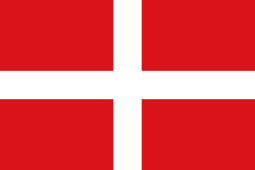 Sovereign Military Order of Malta: Bailiff Knight Grand Cross of Honour and Devotion of the Sovereign Military Order of Malta, 3rd First Class
Sovereign Military Order of Malta: Bailiff Knight Grand Cross of Honour and Devotion of the Sovereign Military Order of Malta, 3rd First Class
-
-
 Ivory Coast: Grand Cross of the National Order of the Ivory Coast
Ivory Coast: Grand Cross of the National Order of the Ivory Coast -
 Japan: Knight Grand Cordon of the Order of the Rising Sun
Japan: Knight Grand Cordon of the Order of the Rising Sun -
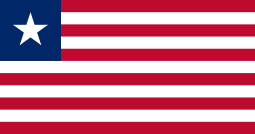 Liberia: Grand Cross of the Order of the Pioneers of Liberia
Liberia: Grand Cross of the Order of the Pioneers of Liberia -
 Luxembourg: Knight Grand Cross of the Order of the Gold Lion of the House of Nassau
Luxembourg: Knight Grand Cross of the Order of the Gold Lion of the House of Nassau -
 Luxembourg: Recipient of the War Cross Medal 1939-1945
Luxembourg: Recipient of the War Cross Medal 1939-1945 -
 Mexico: Grand Cross of the Order of the Aztec Eagle, Special Class
Mexico: Grand Cross of the Order of the Aztec Eagle, Special Class -
 Nepal: Member Grand Cross of the Order of Ojaswi Rajanya
Nepal: Member Grand Cross of the Order of Ojaswi Rajanya -
 Nicaragua: Grand Cross of the Order of Rubén Darío, Special Class
Nicaragua: Grand Cross of the Order of Rubén Darío, Special Class -
 Norway: Knight Grand Cross of the Order of St. Olav
Norway: Knight Grand Cross of the Order of St. Olav -
 Panama: Grand Cross of the Order of Manuel Amador Guerrero
Panama: Grand Cross of the Order of Manuel Amador Guerrero -
 Paraguay: Grand Cross of the National Order of Merit, Special Class
Paraguay: Grand Cross of the National Order of Merit, Special Class -
 Peru: Grand Cross of the Order of the Sun of Peru
Peru: Grand Cross of the Order of the Sun of Peru -
 Poland: Grand Cross of the Order of Military Virtue
Poland: Grand Cross of the Order of Military Virtue -
 Senegal: Grand Cross of the National Order of Merit
Senegal: Grand Cross of the National Order of Merit -
 Spain: Knight Grand Cross of the Order of Charles III
Spain: Knight Grand Cross of the Order of Charles III -
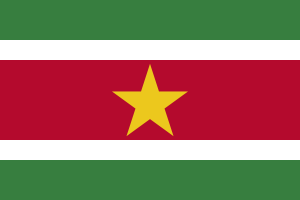 Suriname: Grand Cross of the Honorary Order of the Yellow Star
Suriname: Grand Cross of the Honorary Order of the Yellow Star -
 Sweden: Knight Grand Cross of the Order of the Seraphim
Sweden: Knight Grand Cross of the Order of the Seraphim -
 Thailand: Knight Grand Cordon with Chain of the Order of the Royal House of Chakri
Thailand: Knight Grand Cordon with Chain of the Order of the Royal House of Chakri -
 Tunisia: Grand Cross of the Order of Independence]
Tunisia: Grand Cross of the Order of Independence] -
 United Kingdom: Honorary Knight Grand Cross of the Order of the Bath
United Kingdom: Honorary Knight Grand Cross of the Order of the Bath -
 United Kingdom: Recipient of the France and Germany Star
United Kingdom: Recipient of the France and Germany Star -
 United Kingdom: Recipient of the Defence Medal
United Kingdom: Recipient of the Defence Medal -
 United Kingdom: Recipient of the King George VI Coronation Medal
United Kingdom: Recipient of the King George VI Coronation Medal -
 United Kingdom: Recipient of the Queen Elizabeth II Coronation Medal
United Kingdom: Recipient of the Queen Elizabeth II Coronation Medal -
 United States: Officer of the Legion of Merit
United States: Officer of the Legion of Merit -
 Venezuela: Grand Cross of the Order of the Liberator
Venezuela: Grand Cross of the Order of the Liberator -
 Yugoslavia: Grand Cross of the Order of the Yugoslav Star
Yugoslavia: Grand Cross of the Order of the Yugoslav Star
Military ranks
Military ranks of the Armed forces of the Netherlands
|
|
|
| Royal Netherlands Air Force | Date |
|---|---|
 General General | 27 March 1953 |
Honary Military ranks of Foreign Armed forces
|
|
Ancestry
| Ancestors of Prince Bernhard of Lippe-Biesterfeld | ||||||||||||||||||||||||||||||||||||||||||||||||||||||||||||||||||||||||||||||||||||||||||||||||||||||||||||||||||||||||||||||||||||||||||||||||||||||||||||||||||||||||||||||||||||||||||||||||||||||||||||||||||||||||||||||||||||||||||||||||||||||||||||||||||||||||||||||||||||||||||||||||||||||||||||||||||||||||||||||||||||||||||||||||||||||||||||||||||||||||||||||||||||||||||||||||||||||||||||||||||||||||||||||||||||||||||||||||||||||||||||||||||||||||||||||||||||||||||||||||||||||||||||||||||||||||||||||||||
|---|---|---|---|---|---|---|---|---|---|---|---|---|---|---|---|---|---|---|---|---|---|---|---|---|---|---|---|---|---|---|---|---|---|---|---|---|---|---|---|---|---|---|---|---|---|---|---|---|---|---|---|---|---|---|---|---|---|---|---|---|---|---|---|---|---|---|---|---|---|---|---|---|---|---|---|---|---|---|---|---|---|---|---|---|---|---|---|---|---|---|---|---|---|---|---|---|---|---|---|---|---|---|---|---|---|---|---|---|---|---|---|---|---|---|---|---|---|---|---|---|---|---|---|---|---|---|---|---|---|---|---|---|---|---|---|---|---|---|---|---|---|---|---|---|---|---|---|---|---|---|---|---|---|---|---|---|---|---|---|---|---|---|---|---|---|---|---|---|---|---|---|---|---|---|---|---|---|---|---|---|---|---|---|---|---|---|---|---|---|---|---|---|---|---|---|---|---|---|---|---|---|---|---|---|---|---|---|---|---|---|---|---|---|---|---|---|---|---|---|---|---|---|---|---|---|---|---|---|---|---|---|---|---|---|---|---|---|---|---|---|---|---|---|---|---|---|---|---|---|---|---|---|---|---|---|---|---|---|---|---|---|---|---|---|---|---|---|---|---|---|---|---|---|---|---|---|---|---|---|---|---|---|---|---|---|---|---|---|---|---|---|---|---|---|---|---|---|---|---|---|---|---|---|---|---|---|---|---|---|---|---|---|---|---|---|---|---|---|---|---|---|---|---|---|---|---|---|---|---|---|---|---|---|---|---|---|---|---|---|---|---|---|---|---|---|---|---|---|---|---|---|---|---|---|---|---|---|---|---|---|---|---|---|---|---|---|---|---|---|---|---|---|---|---|---|---|---|---|---|---|---|---|---|---|---|---|---|---|---|---|---|---|---|---|---|---|---|---|---|---|---|---|---|---|---|---|---|---|---|---|---|---|---|---|---|---|---|---|---|---|---|---|---|---|---|---|---|---|---|---|---|---|---|---|---|---|---|---|---|---|---|---|---|---|---|---|---|---|---|---|---|---|---|---|---|---|---|---|---|---|---|---|---|---|---|---|---|---|---|---|---|---|---|---|---|---|---|---|---|---|---|---|---|---|---|---|---|---|---|---|---|---|---|---|---|---|---|---|---|---|---|---|---|---|---|---|---|---|---|---|---|---|---|---|
| ||||||||||||||||||||||||||||||||||||||||||||||||||||||||||||||||||||||||||||||||||||||||||||||||||||||||||||||||||||||||||||||||||||||||||||||||||||||||||||||||||||||||||||||||||||||||||||||||||||||||||||||||||||||||||||||||||||||||||||||||||||||||||||||||||||||||||||||||||||||||||||||||||||||||||||||||||||||||||||||||||||||||||||||||||||||||||||||||||||||||||||||||||||||||||||||||||||||||||||||||||||||||||||||||||||||||||||||||||||||||||||||||||||||||||||||||||||||||||||||||||||||||||||||||||||||||||||||||||
References
- ↑ Jean-Fred Tourtchine, 'Généalogie et état présent des familles princières de Lippe-Biesterfeld (princes souverains de Lippe) et de Lippe-Weissenfeld', in: L'ordre de la noblesse. Familles d'Europe enregistrées in ordine nobilitatis en 1983-1984. Volume sixième 1983-194. [Paris, 1985], p. CCLVXXXVI.
- ↑ Zijl, Annejet van der, Bernhard, een verborgen geschiedenis pp 45 en 87"p 45 ...bood Leopold aan Armgard de oude graventitel van de Biesterfelders toe te kennen – zij het met het laagadellijke 'von' in plaats van het hoogadellijke 'zur'. Deze nieuwe Biesterfelderlijn zou wel meetellen in de erfopvolging, maar in lijn moeten aansluiten achter de overige zijtakken." "p 87 ....kende hij in dit ene en hoogst uitzonderlijke geval ..... alsnog de prinselijke titel 'zur Lippe-Biesterfeld' toe ... en zijn familielijn maakte een flinke sprong vooruit in de erfopvolging."
- ↑ Prinses Armgard verkreeg in 1909 voor haar en haar nakomelingen de titel Gravin (Graaf) van Biesterfeld en in 1916 bij decreet van de laatste regerende vorst van Lippe. Leopold IV die van Prinses (Prins) van Lippe-Biesterfeld. Hierdoor werd de nieuwe Biesterfeldse linie gesticht, die in de rij van hen die tot troonopvolging in Lippe gerechtigd zijn, vóór die van het Lippe-Weissenfeldse vorstelijk huis gaan Gedenkalbum uitgegeven bij het koperen huwelijksfeest van het Koninklijk echtpaar door de NV drukkerij De Spaarnestad Haarlem voor de abonnees van haar periodieken, 1949 p. 12.
- ↑ Waterfield, Bruno (5 March 2010). "Dutch Prince Bernhard 'was member of Nazi party'". The Telegraph. London. Retrieved 13 June 2011.
- ↑ Hélène Grinda: born in 1944, wife of Stanislas, 6e Baron Lejeune (1945–1998), son of Edgard-Louis, 5e Baron Lejeune (born 1915), and wife Claude de Bonardi du Mesnil (1914–1967), by whom she has a son Cyril, 7e Baron Lejeune, born 1972, and daughter of Jean-Paul Grinda (1900–1975) and wife Françoise Blason
- ↑ "Jonathan Aitken is of 'royal blood'". theweek.co.uk. Michael Wolfe. Retrieved 21 November 2014.
- ↑ Westfälische Wilhelms-Universität Münster, NiederlandeNet (23 March 2011). "NiederlandeNet – Monarchie - Personen A-Z - Prinz Bernhard".
- ↑ Hazelhoff, Erik Soldier of Orange (The Holland Heritage Society, New York, 1980) ISBN 0-943010-00-4 P.190
- ↑ Source: Interview with the Prince, 1993, Henny Meyer, published in "Het Vliegerskruis" (1997)
- ↑ In memoriam: Bernhard Prins der Nederlanden (1911-2004), koninklijkhuis
- ↑ DE WERELD – herdenking en interview met Prins Bernhard 35 jaar na de bevrijding. Video footage of 1980 commemoration of the German capitulation at "Hotel de Wereld" in Wageningen, opening speech by the Prime Minister, and interview with Prince Bernhard. (Dutch)
- ↑ TE WAGENINGEN Historic video footage (black and white, no audio).
- ↑ "KLM accused of helping Nazis flee". BBC News. 8 May 2007.
- ↑ BEZOEK AAN DE VERENIGDE STATEN. Historic video footage of the Royal visit to the USA.
- ↑ "Netherlands' Prince Bernhard dies". BBC News. 2 December 2004. Retrieved 3 May 2016.
- ↑ "Outspoken Dutch Prince Bernhard always in the public eye". TerraDaily. 1 December 2004. Retrieved 3 May 2016.
- ↑ "Peace Parks Foundation". Peace Parks. 1997. Retrieved 3 May 2016.
- ↑ "Leven Mandela in foto's". Telegraaf. 5 December 2013. Retrieved 3 May 2016.
- ↑ "AN EARTH TOUCH TRIBUTE TO FORMER PRESIDENT NELSON MANDELA". EarthTouch. 6 December 2013. Retrieved 3 May 2016.
- ↑ "Prins Bernhard en Mandela openen wildpark". NederlandsDagblad. 29 August 2003. Retrieved 3 May 2016.
- ↑ "The Bilderberg Group: fact and fantasy". The Daily Telegraph. 4 Jun 2010. Retrieved 3 May 2016.
- ↑ "Opening Words at 1st ever Bilderberg meeting". YouTube. 29 May 1954. Retrieved 3 May 2016.
- ↑ "Het geheim van de Bilderberg-conferenties". NPO. 6 June 2013. Retrieved 3 May 2016.
- ↑ "Tweelingzus laatste sjah van Iran overleden". NOS. 8 January 2016. Retrieved 3 May 2016.
- ↑ "Reza Pahlavi te gast in Den Haag". Royalblog.nl. 30 May 2012. Retrieved 3 May 2016.
- ↑ "Stephen Dando-Collins: WWII Dutch airlift manna from heaven". The Australian. 23 May 2015. Retrieved 6 May 2016.
- ↑ "PRINS BERNHARD ONTMOET IAN FLEMING". NRC Handelsblad. 2 February 2008. Retrieved 6 May 2016.
- ↑ "James Bond was Dutch". RNW Media Handelsblad. 4 April 2012. Retrieved 6 May 2016.
- ↑ (Dutch) Interview (Dutch) with historian Fasseur. Volkskrant.nl. 12 November 2008
- ↑ Browne, Anthony (4 December 2004) From beyond the grave, Prince finally admits taking $1m bribe. Timesonline.co.uk. Retrieved on 23 April 2014.
- ↑ "Pretoria inquiry confirms secret battle for the rhino". The Independent. London. 18 January 1996.
- ↑ Dead prince admits Dutch bribery scandal at the Wayback Machine (archived 23 May 2011). Timesonline.co.uk. 3 December 2004.
- ↑ (Dutch) ARCHIEF – De prins is dood, de prins spreekt – Binnenland – VK. Volkskrant.nl (14 December 2004). Retrieved on 23 April 2014.
- ↑ Archived 15 April 2009 at the Wayback Machine..
- ↑ (Dutch) Dutch newspaper article about the book release. Volkskrant.nl (16 January 2010). Retrieved on 23 April 2014.
- ↑ ANP (National Press Association of the Netherlands) news coverage summary. Nu.nl. Retrieved on 23 April 2014.
- ↑ Erik Varekamp on Comiclopedia
- Varekamp, E. en Peet, M. (2004), Agent Orange, De jonge jaren van Prins Bernhard. Amsterdam: Uitgeverij Van Praag. ISBN 904903201X
- Varekamp, E. en Peet, M. (2005), Het grote Prins Bernhard aankleedboek. Amsterdam: Uitgeverij Van Praag. ISBN 9049032036
- Varekamp, E. en Peet, M. (2006), Agent Orange, Het huwelijk van Prins Bernhard. Amsterdam: Uitgeverij Van Praag. ISBN 978-9049032043
- Varekamp, E. en Peet, M. (2008), Agent Orange, De oorlogsjaren van Prins Bernhard I. Amsterdam: Uitgeverij Van Praag. ISBN 9789049032074
- Varekamp, E. en Peet, M. (2010), Agent Orange, De oorlogsjaren van Prins Bernhard II, De stadhoudersbrief. Amsterdam: Uitgeverij Van Praag. ISBN 9789049032098
- Varekamp, E. en Peet, M. (2012), Agent Orange, De oorlogsjaren van Prins Bernhard III, De affaire Kingkong. Amsterdam: Uitgeverij Van Praag. ISBN 9789049032128
- ↑ "Queen's father a creature of his own myths"
- ↑ Decree about the titles and names of Prince Bernhard after his marriage with Princess Juliana – Website with Legislation concerning the Royal House of the Netherlands (Dutch)
- ↑ Staatsalmanak voor het Koninkrijk der Nederlanden (in Dutch). The Hague: Sdu Uitgevers. 2004. pp. A2–A3. ISBN 90-121-0543-9.
- ↑ "Reply to a parliamentary question about the Decoration of Honour" (PDF) (in German). p. 111. Retrieved November 2012. Check date values in:
|access-date=(help) - ↑ Badraie. Badraie. Retrieved on 23 April 2014.
- ↑ The London Gazette: (Supplement) no. 43434. p. 7765. 11 September 1964. Retrieved 3 June 2009.
External links
| Wikimedia Commons has media related to Bernhard of Lippe-Biesterfeld. |
- Official Biography (Summary) Official Dutch Royal Website
- Prince Bernhard takes delivery of his second Corgi
- Dutch Royal House official website
- The World Wildlife Fund website
- Official memorial
- Article about Prince Bernhard during World War II on Go2War2 (Dutch)
- The Mars en Mercurius website
- Historic video footage Montgomery visit 1945.
- Historic video footage Churchill visit 1946.
- Historic video footage Eisenhower visit 1951.
| Prince Bernhard of Lippe-Biesterfeld Born: 29 June 1911 Died: 1 December 2004 | ||
| Dutch royalty | ||
|---|---|---|
| Vacant Title last held by Duke Henry of Mecklenburg-Schwerin |
Prince Consort of the Netherlands 1948–1980 |
Succeeded by Claus von Amsberg |
| Non-profit organization positions | ||
| First | Chairmen of the Bilderberg Group 1954–1976 |
Succeeded by Walter Scheel |
| Chairman of Oxfam Novib 1956–1971 |
Succeeded by Unknown | |
| President of the World Wide Fund for Nature 1961–1977 |
Succeeded by John Hugo Loudon | |
| Military offices | ||
| Vacant Title last held by Henri Winkelman |
Commander-in-chief of the Armed forces of the Netherlands 1944–1945 |
Vacant Title next held by Hendrik Johan Krulsas Chief of the Netherlands Defence Staff |
| First | Inspector General of the Royal Netherlands Army 1945–1970 |
Last Became Inspector General of the Armed forces of the Netherlands |
| Inspector General of the Royal Netherlands Navy 1946–1970 | ||
| Inspector General of the Royal Netherlands Air Force 1953–1970 | ||
| Inspector General of the Armed forces of the Netherlands 1970–1976 |
Succeeded by Witius Henrik de Savornin Lohman | |










